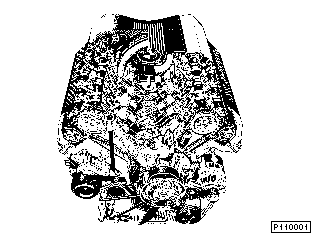
The functional description contains the following sections:
INTRODUCTION
The M62 engine series replaces the M60 engine. The M62 engine is a consistent further development of the BMW V-8 cylinder engine series introduced in 1992. As of 1/96 it will be installed in the series E31, E38 and E39 over a staggered period of time.
The new M62 engine is based on the M60 engine with regard to its essential features:
The M62 engine is offered in two capacity variants, i.e. a 3.5 l and a 4.4 l variant.
It is installed in the following model series:
Model series / engine |
M62B35 |
M62B44 |
|---|---|---|
E31 |
- |
840i |
E38 |
735i |
740i |
E39 |
535i |
540i |

Engine M62 |
|
The most important objectives of the further development were compliance with new legal stipulations and improvement of comfort and quality.
Particular attention was paid to the following features:
Essentially, these objectives were realised by increasing the engine capacity, modifications to the crank drive, modifications to the camshaft drive, further development of various engine components as well as by implementing the new digital motor electronics DME M5.2.
For production reasons (production capacity at crankcase manufacturer), two different aluminium alloys are used in the production of the crankcase.
The crankcases of engines for markets with critical fuel quality (high sulphur content in fuel) are made of Alusil (same as M73). These are engines for
In the same way as the M73 engine, the crankcase of these engines is made from an aluminium alloy (Alusil) in a chilled casting process. The cylinder barrels are not coated. The required surface quality of the cylinder barrels is achieved by means of an etching process as part of the production process.
The crankcases of the M62 engines for all other markets are made of the aluminium alloy (AlSi9Cu3) as known from the M60 engine. The cylinder barrels of these crankcases are coated in a nickel-dispersion process (Nikasil)
The part number serves as the external identification feature for both crankcase variants (aluminium alloys). The two material variants of the crankcases also feature correspondingly different surface coatings for the pistons (refer to 'Pistons').
Irrespective of the different production methods, the design of the crankcases is identical for both variants.
As already fitted on the M52 and M73, piston cooling by means of hook-type nozzles is implemented on the M62. These hook-type nozzles are screwed directly into the bearing blocks. With the aid of these hook-type nozzles, the oil jet is directed at the piston crown over the entire path of piston travel.
The hook-type nozzles are assembled and disassembled in a different way than known from the M52 / M73. Please follow repair instructions!
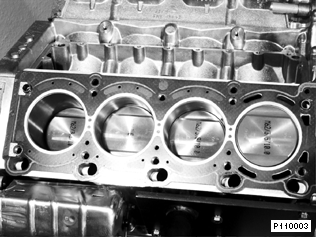
M62 engine block with pistons |
|
Due to the extended stroke, the crankshaft is new for both engine capacity variants. As on the M60, it is mounted in 5 bearings. The crank pins are offset by 90 o . Six counterweights ensure smooth engine operation.
The crankshaft is forged in steel for both M62 engine capacity variants. Weight is reduced by the central hollow cavity.
Corresponding to the two different aluminium alloys used for the crankcase (dependent on country variant), the pistons and piston rings feature different surface coatings. The pistons for the crankcases made of Alusil are ferrous-coated. The pistons are differentiated by their part numbers.
If pistons need be replaced during repairs, care must be taken particularly on vehicles from foreign markets to ensure that the pistons and piston rings, allocated to the crankcase on the basis of their corresponding part numbers, are installed.
Irrespective of the surface coating, the design of the pistons is identical (full slipper skirt pistons).
The pistons are designed to enable operation with fuel RON 95. The compression ratio for both engine capacity variants is 10.0 : 1.
The connecting rods are of the same design as on the M60 engine.
For the first time on the M60 engine and now also on the M62 engine, sintered metal connecting rods are fitted. In addition to the lower weight (moved masses), these connecting rods offer high strength over the entire output range of an engine.
The connecting rod and the big-end bearing cap are separated during manufacture of the forged sintered connecting rods. This renders conventional centring by means of fitted dowels during assembly unnecessary. Centring is achieved by means of the break structure and the guide for the connecting rod bolts. Taring (coloured dots or identification numbers for the weight class) is not necessary thanks to the high production accuracy achieved in the sintered forging process.
On the M62 engine, new antifatigue bolts are used to secure the connecting rod to the crankshaft.
In connection with the automatic transmission, the flywheel is of a one-piece design and made of steel. A hydraulically dampened dual mass flywheel (ZMS) is used on manual transmission vehicles.
As on the M73 engine, the increment gearing for the crankshaft sensor is located on the flywheel for both variants. The inductive pulse generator is mounted in the transmission/clutch bell housing. The new installation location for the increment wheel on the flywheel now makes it possible for the DME control unit to detect misfiring.
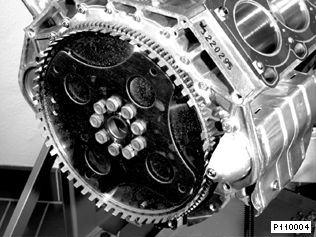
Flywheel with increment gearing |
|
On the previous engines, the increment wheel was mounted radially dampened by means of a vulcanised rubber element on the torsional vibration absorber. With this arrangement, it would not be possible to detect irregularities in engine speed.
On the flywheel, the increment wheel is connected rigidly to the crankshaft without a damping element.
In this way, irregularities in engine speed, caused by misfiring for example, are transmitted directly to the increment wheel. In addition to the engine speed and reference mark, misfiring caused by faults in the ignition or fuel injection systems can now be detected with the inductive pulse generator. Misfiring detection is a requirement laid down in OBD II (US).
You will find a detailed description of the operating principle of misfiring detection in Section DME.
As on the E38 M60, the oil pan is of a two-piece design. The upper part is an aluminium die casting. The bottom part of the oil pan is based on a double sheet metal plate design.
The oil filling capacities are identical to those of the M60 engine.
The oil filling capacities for both M62 engine displacement variants are:
The difference between 'MIN' and 'MAX' on the dipstick is 1.5 l.
The oil pump housing and the oil pump cover of the M62 are made of aluminium die casting (M60 magnesium). The design and drive of the oil pump are identical to those of the M60.
As in the E38 M60 and in the M73 engines, a thermal oil level sensor is fitted in the M62.
This oil level sensor sends a pulse width modulated signal to the check-control module (E31: CCM; E38/E39: LCM).
The pulse duty factor of this signal is a measure for the oil level in the engine. If the level drops below a threshold value stored in the CCM/LCM control unit, the check control message "Check engine oil level" is displayed for the driver.
You will find a technical description in the Trainer's Guide Instrument Cluster Electronics IKE / I-Bus Network E38.
The oil filter is of identical design as that on the M62, however, the filter housing is secured on the body.
As on the M60, the crankcase is ventilated by means of a pressure-controlled system. The design of the crankcase ventilation is the same as the system already known from the M60.
The blow-by gasses which are produced during engine operation collect in the crankcase.
The intake system is connected to the crankcase by means of a pressure control valve integrated in the end cover of the intake system. The resulting vacuum draws off the blow-by gasses in the crankcase via a cyclone separator.
The oil vapours contained in the blow-by gasses condense on the cool walls of the cyclone separator and are returned to the oil sump via a return line. The remaining gaseous components are fed via a distributor pipe in the intake system to the mixing chamber in the throttle housing.
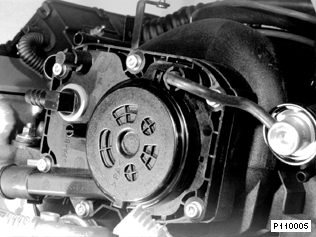
Pressure control valve in intake system |
|
The 4-valve cylinder heads of the M62 basically correspond in design to those of the M60, however, they are not a common part. To facilitate external differentiation, the lettering M60 or M62 as well as the relevant capacity variant (e.g. B35) are cast in the unmachined blank.
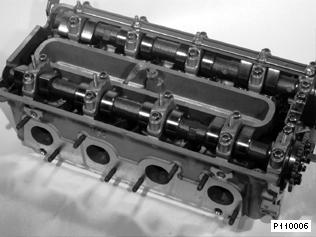
M62 cylinder head |
|
Cylinder head gasket
The cylinder head gasket is asbestos-free. In contrast to the cylinder head gasket of the M60, it no longer covers the area of the timing case cover. A new rubber formed gasket is now used in this area (refer to timing case cover). For this reason, the identification designation of the cylinder head gasket (3.5 l / 4.4 l) has been relocated towards the rear.
Cylinder head cover
The cylinder head cover is made of magnesium.
Care must be taken to avoid damaging the surface of the magnesium cylinder head covers as surface damage increases the risk of corrosion.
Two overhead camshafts are allocated to each cylinder head. In the same way as the camshafts of the M60 engine, they are designed as solid shafts made of high-carbon steel casting.
The angle position of the engagement dihedron of the camshafts has been adapted to the existing M60 engagement tools. In this way, the M60 engagement tools can also be used for setting the M62 camshafts.
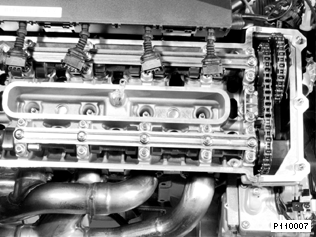
Cylinder head with camshafts and oil lines |
|
Camshaft identification
As on the M60, the camshafts are identified by punched alphanumeric combinations (E1-4, A1-4, E5-8, A5-5).
The main aim in the design of the valve train was to reduce the moved masses. The masses of the hydraulic tappets, the valve springs and of the upper valve spring retainer have been considerably reduced in conjunction with lower frictional torque and noise reduction. This has made it possible to achieve lower frictional torque and reduction in noise.
Valves
With regard to their dimensions and weight, the valves are identical to those on the M60 (common part M60).
HVA bucket tappets
The diameter of the HVA bucket tappets has been reduced (M60: (35 mm / M62: (33 mm). In this way it has been possible to reduce the weight by 32g to 48g (M60: 80g)(common part M52). These are INA bucket tappets, self-venting with carbon nitrited cam surface.
Valve springs
The use of conical single valve springs has made it possible to reduce the moved masses even further.
Spring retainer
The weight of the top spring retainer has also been optimised (common part M44 and M52). The bottom spring retainer is a common part with M52.
As a whole, a distinct reduction in weight of the valve train has been achieved by these measures as illustrated in the table below.
|
M60B40 |
M62B44 |
|---|---|---|
Inlet valve (g) |
49 |
49 |
Exhaust valve (g) |
48 |
48 |
HVA bucket tappets (g) |
80 |
48 |
Valve spring(s) (g) |
36 |
12 |
Upper valve retainer (g) |
15 |
8 |
Valve collets (g) |
1 |
1 |
Inlet per valve (g) |
181 |
118 |
Outlet per valve (g) |
180 |
117 |
Primary drive
To facilitate precision optimisation with regard to noise, weight and friction, the primary drive is transmitted via a single roller chain (M60: double roller chain) from the crankshaft to the inlet camshaft. The primary drive sprockets are rubberized to enable low-noise engagement of the chain.
Camshaft sensor wheel
A sensor wheel with 4 sensor markings for identifying cylinder number 1 (DME) is mounted on the inlet camshaft sprocket for cylinders 1-4. In contrast to the M60 (inductive position sensor), a hall sensor is used as the camshaft position sensor on the M62 engine.
Due to the new design of the camshaft position sensor wheel, positioning of the sensor wheel for the camshaft drive has also been newly defined. The camshaft sensor wheel now features a mark (notch). Particular care must be taken during assembly to ensure that this mark faces downward with respect to the cylinder axis. For more details, refer to the repair instructions.
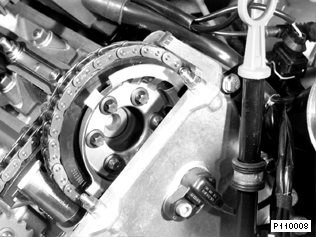
M62 camshaft sensor wheel |
|
Deflection rail for primary chain
The deflection wheel in the V-chamber has been replaced on the M62 by an aluminium deflection rail with clip-on plastic track. The chain is tensioned by means of a hydraulic chain tensioner with a pressure limiting facility.
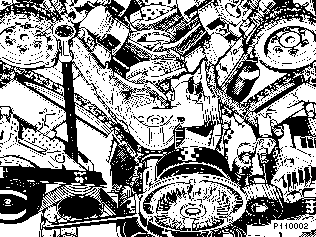
M62 engine with deflection rail for primary drive |
|
Due to the use of a deflection rail (instead of the deflection wheel), during assembly of the primary drive, modified torque values for pretensioning the rail must be observed (refer to repair instructions).
Secondary drive
The secondary drive is also based on a single roller chain. It extends from the inlet camshafts to the exhaust camshafts.
A hydraulic chain tensioner is integrated on each cylinder head
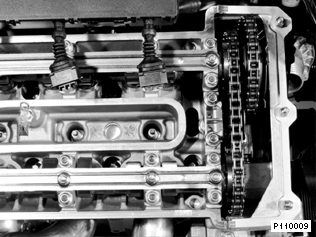
M62 cylinder head with single roller chains |
|
As on the M60, the timing case covers are attached at the cylinder heads and at the central crankcase.
The sealing system is new:
The two upper timing case covers are sealed with respect to the cylinder head and the lower timing case cover by means of a rubber formed gasket. This rubber formed gasket achieves better tolerance compensation and acoustic decoupling between the lower and upper timing case covers.
Due to the use of the modified gasket, a new procedure for assembling the upper timing case cover must be observed in order to achieve the optimum sealing effect. Refer to assembly not in repair instructions!
The lower timing case cover is sealed with respect to the crankcase by means of a flat gasket.
The throttle body of the M62 has been newly designed. A mixing chamber has been realised in the area of the orifice for idle air control (ZWD 2).
This mixing chamber is formed by a plate with precisely designed orifices installed between the intake system and throttle valve.
The air for the idle actuator, the purge air of the carbon canister and the blow-by gasses via the uniform distribution pipe, leading from the pressure control valve for crankcase ventilation to the throttle housing, flow into this mixing chamber. Here, the blow-by gasses and the purge air of the carbon canister are mixed with fresh air. This ensures all cylinders receive the blow-by gasses uniformly thus providing a smooth and uniform idle quality.
The intake manifold of the M62 is a one-piece plastic part. It corresponds to that fitted on the M60B40.
The pressure control valve for crankcase ventilation is mounted directly on the intake manifold. A distribution pipe leads from the pressure control valve through the intake manifold to the mixing chamber in the throttle valve in order to evenly distribute blow-by gasses over all cylinders.
A connection for the Master-Vac of the brake booster is provided in the cover of the intake manifold.
In the same way as the majority of BMW engines, the M62 features a static high-voltage distribution system.
Ignition coils
New ignition coils are used for the M62 engine. The ignition coils are of the same design as those fitted on the M52 engine. Due to their modified mechanical design, they are smaller and lighter compared to the ignition coils used to date.
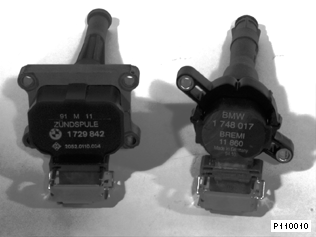
Comparison of ignition coils M60 - M62 |
|
A compact alternator (140 A) with fresh air intake is used on all vehicles equipped with the M62 engine.
A water-cooled 220 A alternator is still used on E31 vehicles (two batteries in luggage compartment!) with increased power requirements and thus a higher closed-circuit current (due to special options such as in-car telephone or independent heating).
In connection with the special option air conditioning, a 3-stage electrically powered auxiliary fan is used in the E39.
This auxiliary fan is a standard feature in the models E31 and E38 since the air conditioning system is standard equipment in these vehicles.
To facilitate noise optimisation, the previous two-stage circuit has been extended by a third stage. The cut-in criteria for the individual stages have been redefined.
Cut-in criteria
Cut-in |
Stage I |
Compressor clutch active and outside temperature> 10 o C. - Water temperature> 91 o C. |
Cut-in |
Stage II |
- Pressostat medium pressure switch closed > 21 bar |
Cut-in |
Stage III |
- Water temperature> 104 o C. (Cut-in via dual temperature switch) |
Cut-out |
Stage IV |
-Compressor clutch inactive - outside temperature < 8 o C. -Water temperature < 91 o C |
As on the M60, the starter used for all variants is a 12 V Bosch countershaft starter with an output power of 1.7 kW.
The lines and line arrangement to the battery charge terminal point are new in the series E38 and E39. The B+ lead is routed under the engine to the alternator and to the battery charge terminal point.
The battery charge terminal point is located on the timing case cover of cylinder bank 5 - 8.
On the E31, the battery charge terminal point is still located on the right-hand MacPherson strut tower.
The complete exhaust system from the manifold to the tail pipe is made of stainless steel and is one piece from the manifold flange downward.
Exhaust manifold
As on the M60, air-gap insulated sheet metal exhaust manifolds are used on the M62.
Catalytic converter
The headpipes are also air gap-insulated double pipes (tube-in-tube).
Catalytic converter is of a twin flute design each with 2 trimetall layers (platinum, palladium, rhodium) ceramic monolith per exhaust line. In order to achieve the lowest possible exhaust gas backpressure, the monoliths have the same cross section as those on the M73.
The principle design of the water circuit corresponds to that of the M60 engine.
Water pump
The design of the water pump is identical to that of the M60 engine. The housing is an aluminium die casting and is secured on the timing case cover. Differing from the M60, a dual temperature sensor for the coolant is installed in the water pump housing. This dual temperature sensor is located at the point where the coolant flows out of the engine.
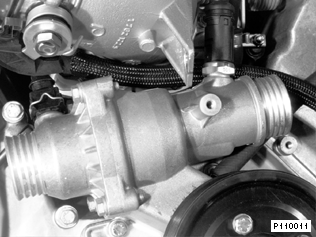
Detail view water pump with dual temperature sensor |
|
Radiator
The design of the M62 radiator is identical to that fitted on the M60 engine.
An engine oil cooler is additionally fitted for specific country variants.
The thermostat is integrated in the housing of the water pump.
As on the M60, a conventional thermostat with integrated vent valve is installed on the E31 with M62 engine. This thermostat opens at 85 o C.
A new characteristic map-controlled thermostat is used on the vehicle series E38 and E39 with M62 engine.
Function of a conventional thermostat
The control of the engine cooling system with a conventional thermostat is determined by the coolant temperature only. This control system can be subdivided into three operating ranges:
With the aid of the characteristic map thermostat, the coolant temperature can now be influenced specifically within this operating range (thermostat control range).
In this way it is possible to set a higher coolant temperature in the partial load range of the engine. Higher operating temperatures in the partial load range achieve improved combustion, reflected in lower fuel consumption and pollutant emission.
However, higher operating temperatures in the full load range would involve specific disadvantages (ignition timing (angle) reduction due to knocking). For this reason, lower coolant temperatures are set specifically in the full load range with the aid of the characteristic map thermostat.
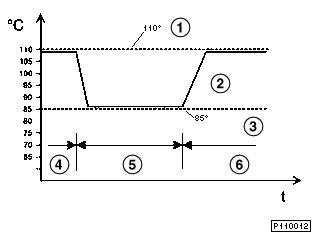
|
Control characteristics of characteristic map cooling |
|---|---|
1 |
Characteristic curve of a 110 o C thermostat |
2 |
Characteristic curve of a characteristic map thermostat |
3 |
Characteristic curve of an 85 o C thermostat |
4 |
Partial load range |
5 |
Full load range |
6 |
Partial load range |
BMW is thus the first automobile manufacturer worldwide to use a characteristic map-controlled thermostat for specific control of the coolant temperature in a large volume production engine. With the aid of this thermostat it is possible to specifically increase the coolant temperature in the partial load range. By increasing the coolant temperature under these engine operating conditions, it is possible to reduce fuel consumption. The characteristic map thermostat is controlled by the DME M5.2 in conjunction with a characteristic map.
This characteristic map is determined by the following factors:
Design of a characteristic map thermostat
The characteristic map thermostat is an integral thermostat, i.e. the thermostat and thermostat cover make up one unit.
The principle mechanical design of the characteristic map thermostat corresponds to that of a conventional thermostat. However, a heating element is additionally integrated in the expansion element (wax element).
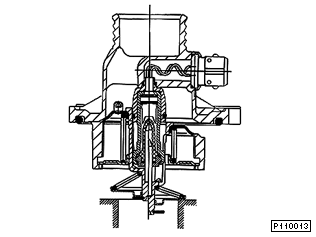
Cross sectional view of the characteristic map thermostat |
|
The cover of the characteristic map thermostat is made of an aluminium die casting. The electrical connection for the heating element linked to the expansion element of the characteristic map thermostat is integrated in the thermostat cover.
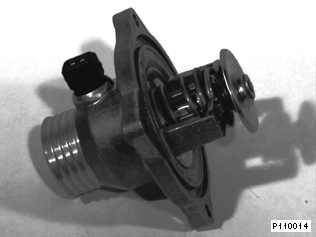
Characteristic map thermostat with electrical connection for heating element |
|
Function of the characteristic map thermostat
The characteristic map thermostat is designed such that it opens (engine inlet) at a coolant temperature at the thermostat of 103 o C without intervention of the integrated heating system. Due to the coolant heating up in the engine, a temperature of approx. 110 o C is measured at the point the coolant flows out of the engine (installation location of coolant temperature sensor for DME and instrument cluster gauge). This is the operating temperature of the engine, at which the characteristic map thermostat begins to open without control intervention.
In the event of control intervention by the DME control unit, power (12 V) is applied to the heating element integrated in the thermostat. Heating the expansion element means that the thermostat now opens at lower coolant temperatures than would be the case without the additional heating function (thermostat control range: approx. 80 o C - 103 o C).
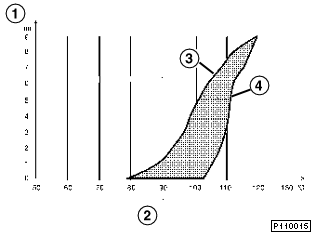
1 |
Opening path of the thermostat |
2 |
Coolant temperature |
3 |
Activation of heating element with 12 V |
4 |
Activation of heating element with 0 V |
If the coolant temperature exceeds 113 o C at the engine outlet, the heating of the characteristic map thermostat is activated by the DME irrespective of the other parameters.
Diagnosis
The line connection and the function of the characteristic map thermostat are monitored by the diagnosis function in the DME control unit. Any faults are stored in the fault code memory of the DME control unit.
Coolant temperature gauge
The indicator characteristics of the coolant temperature gauge in the instrument cluster have been adapted to the higher temperature level of the engine due to the use of the characteristic map thermostat.
The pointer of the coolant temperature gauge in the instrument cluster is located in the mid-position at coolant temperatures of
75 o C - 113 o C
The digital motor electronics DME M5.2 from Bosch as already used in the M73 is now used on the M62 engine. It replaces the DME M3.3 of the M60 engine.
This new version of the DME has been developed to meet the objectives specified in the introduction and to comply with new American legislation (e.g. OBD II). The Californian standards in particular stipulate very stringent requirements with regard to exhaust emission values.
These CARB functions (Californian Air Resource Board) are realised in the DME M5.2.
The vehicles designated for the American market are equipped with an on-board diagnosis (OBD) interface which is standardized for all vehicle manufacturers. This interface makes it possible for the state traffic supervisory authority to read out OBD-relevant information from the DME fault code memory at any time. Access to this limited scope of fault code memory information is enabled by internal coding in the DME control unit.
The most important features of the DME M5.2 are:
In order to monitor compliance with exhaust emission limit values, the Californian and US legislation require monitoring of all emission-related components during vehicle operation. This made more effective self-diagnosis necessary which, among other things, includes a misfiring detection function. If an emission-related fault occurs, the DME activates the 'check engine' lamp in the instrument cluster on US vehicles. This signals to the driver that a fault has occurred in the engine management system which influences exhaust emission and must therefore be eliminated immediately in a specialist workshop.
The most important OBD II diagnosis functions are:
A further component part of the OBD II system is an interface which is standardized for all vehicle manufacturers and which can be used by US traffic supervisory authorities to read out emission-related faults stored in the control unit with the aid of a scan tool. Access to the data in the fault code memory is restricted for these authorities to emission-related faults.
With the exception of the functions
All OBD II-relevant monitoring functions which are not designated for the US market are also realised in the DME 5.2 control units. The standardized OBD II interface which permits supervisory authorities access to the fault code memory is also installed only in US vehicles.
The rotary speed of the engine is measured at the increment wheel with the aid of the inductive pulse generator. In addition to measuring the engine speed, misfiring is also detected on the M62 (same as M73).
To facilitate misfiring detection, the increment wheel is now subdivided internally in the control unit into four segments corresponding to the ignition interval (on 8-cylinder engine, 4 ignition cycles per crankshaft revolution).
The period duration (T) of the individual increment wheel segments is measured in the control unit. If the combustion sequence is OK in all cylinders, the period duration of all increment segments will be of the same length (T1 = T2 = T3 = T4).
If a fault (misfiring) now occurs at one cylinder, the period duration allocated to this cylinder is extended by fractions of milliseconds (see Fig.: T3> T1, T2, T4). These segment times are evaluated statically in the control unit.
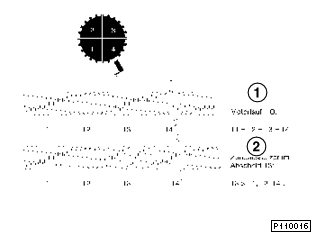
|
Principle of misfiring detection |
|---|---|
1 |
Engine operation OK. |
2 |
Misfiring in section T3 |
The maximum permissible irregularity values, i.e. the deviation of the period duration of one segment are stored for each characteristic map point as a function of engine speed, load and engine temperature.
On exceeding these permissible values, the cylinders detected as faulty are stored in the fault code memory. In this case, the 'check engine' lamp is activated on US vehicles.
As a further measure, fuel injection to the faulty cylinders is switched off in order to protect the catalytic converter from overheating.
Adaptation
Manufacture-related tolerances of the increment wheel can lead to malfunctions of the misfiring detection system. For this reason, the DME automatically carries out adaptation.
The manufacture-related tolerances of the increment wheel are adapted in coasting phases of the engine without ignition and injection as the engine produces no irregularities due to the combustion procedure in these phases.
Service note:
After replacing a flywheel, increment sensor or DME control unit, particular care must be taken as part of the subsequent test run to ensure that a longer engine cruising phase (approx. 10 sec) is maintained to make it possible for the DME control unit to adapt the flywheel.
Digital data transfer between the following control units takes place via the CAN-bus link:
Conical jet valves (as on M60) from Bosch and Lucas are used for both engine capacity variants.
As on the M60, a hot-film air mass meter is used on the M62.
As on the M60, the idle speed is controlled on the M62 engine by means of a two-winding rotary actuator (ZWD 5). The air drawn in by the ZWD 5 at idling speed is routed to the mixing chamber of the throttle valve.
An oxygen sensor is arranged upstream of each of the two catalytic converters. The M62 models designated for the US market are additionally equipped with a second oxygen sensor (monitor) downstream of the catalytic converter in order to comply with OBD II regulations. The oxygen sensors are of identical design to those on the M73 engine. (Type designation: Bosch LSH 25).
The M62 also features a knock control system. The knock control prevents knocking engine operation. For this purpose, if there is a risk of knocking, the control retards the ignition timing of the corresponding cylinder(s) as far as necessary.
The 4 knock sensors are mounted on the water jacket of the engine block between the two rows of cylinders. They are arranged such that one sensor monitors the two adjacent cylinders. The design and function of the knock sensors are identical to those of the M60.
A dual temperature sensor is used on the M62 (as on M52). It serves the purpose of registering the coolant temperature both for the engine management system as well as for the remote thermometer in the instrument cluster. For this purpose, two galvanically isolated NTC pellets with different resistance characteristic curves are integrated in the sensor.
The dual temperature sensor is mounted on the end face of the engine in the water pump housing.
The automatic start function serves to improve driver comfort during the starting procedure. In order to start the engine, it is only necessary to turn the ignition key into the 'start' position for a short time (terminal 50). After the DME control unit has received the input signal from terminal 50, the starter motor is activated until the engine starts up. All E38 vehicles with M73 engine are already equipped with this function.
Now all E38 and E39 vehicles with M62 engine are equipped with the automatic start function in conjunction with the special option automatic transmission.
Function
The starter relay is no longer activated directly via terminal 50 with the automatic start function. Terminal 50 now only serves as an input signal for the DME 5.2.
When the DME 5.2 control unit receives the incoming start signal (terminal 50) and the EWS control unit detects the correct change code at the same time, the DME activates the starter relay via the 'automatic start' output. The prerequisite for this is that the gear selector lever is in 'P' or 'N' position.
The starter motor is activated by the starter relay until 'engine running' is detected by the crankshaft sensor.
'Engine running' is detected when the engine speed
is temporarily exceeded during the starting procedure.
On detecting the 'engine running' signal, the DME control unit switches off the starter relay. If starting the engine is unsuccessful, the automatic start procedure is terminated after 20 sec by a ground signal output by the DME.
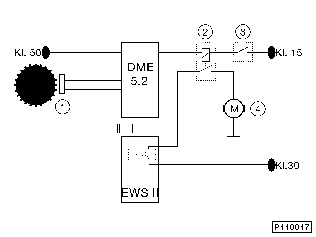
|
Function diagram 'Automatic start' |
|---|---|
1 |
Crankshaft sensor |
2 |
Starter relay |
3 |
With automatic transmission (L2) |
All vehicles with M62 engine are equipped with ASC+T as standard. In order to implement the ASC functions, the M62 engine is equipped with a choke (as on the M60) which is controlled by the ADS II actuator as required in conjunction with a bowden operating cable assembly.
The ABS II actuator is controlled by the ABS/ASC control unit. Other ASC interventions such as ignition timing adjustment as well as ignition and injection cutout are controlled by the DME control unit.
The idle speed actuator (ZWD 5) is also used on the M62 engine to realize the engine drag torque control function (MRS). The idle speed actuator opens specifically when the engine drag torque control (MSR) is activated. It receives a pulse width modulated signal from the DME for this purpose.
The information necessary to control the ASC functions in the DME control unit is transferred via the CAN-bus.